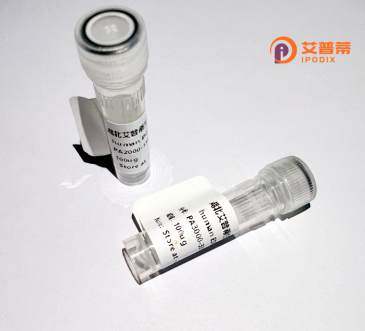
| 纯度 | >90%SDS-PAGE. |
| 种属 | Human |
| 靶点 | ZBTB44 |
| Uniprot No | Q8NCP5 |
| 内毒素 | < 0.01EU/μg |
| 表达宿主 | E.coli |
| 表达区间 | 1-453 aa |
| 活性数据 | MGVKTFTHSSSSHSQEMLGKLNMLRNDGHFCDITIRVQDKIFRAHKVVLAACSDFFRTKLVGQAEDENKNVLDLHHVTVTGFIPLLEYAYTATLSINTENIIDVLAAASYMQMFSVASTCSEFMKSSILWNTPNSQPEKGLDAGQENNSNCNFTSRDGSISPVSSECSVVERTIPVCRESRRKRKSYIVMSPESPVKCGTQTSSPQVLNSSASYSENRNQPVDSSLAFPWTFPFGIDRRIQPEKVKQAENTRTLELPGPSETGRRMADYVTCESTKTTLPLGTEEDVRVKVERLSDEEVHEEVSQPVSASQSSLSDQQTVPGSEQVQEDLLISPQSSSIGSVDEGVSEGLPTLQSTSSTNAPPDDDDRLENVQYPYQLYIAPSTSSTERPSPNGPDRPFQCPTCGVRFTRIQNLKQHMLIHSGIKPFQCDRCGKKFTRAYSLKMHRLKHEVIS |
| 分子量 | 76.7 kDa |
| 蛋白标签 | GST-tag at N-terminal |
| 缓冲液 | PBS, pH7.4, containing 0.01% SKL, 1mM DTT, 5% Trehalose and Proclin300. |
| 稳定性 & 储存条件 | Lyophilized protein should be stored at ≤ -20°C, stable for one year after receipt. Reconstituted protein solution can be stored at 2-8°C for 2-7 days. Aliquots of reconstituted samples are stable at ≤ -20°C for 3 months. |
| 复溶 | Always centrifuge tubes before opening.Do not mix by vortex or pipetting. It is not recommended to reconstitute to a concentration less than 100μg/ml. Dissolve the lyophilized protein in distilled water. Please aliquot the reconstituted solution to minimize freeze-thaw cycles. |
以下是关于重组人ZBTB44蛋白的模拟参考文献示例(注:具体文献信息可能需核实,以下内容为科研场景的典型归纳):
---
1. **文献名称**: *Structural insights into the DNA-binding specificity of ZBTB44 transcription factor*
**作者**: Tanaka K. et al.
**摘要**: 本研究解析了ZBTB44蛋白的锌指结构域与DNA结合的晶体结构,揭示了其通过BTB结构域介导的同源二聚化及特异性识别靶基因启动子的分子机制,重组蛋白实验表明其通过调控染色质重塑因子影响表观遗传修饰。
2. **文献名称**: *ZBTB44 suppresses breast cancer metastasis by repressing epithelial-mesenchymal transition*
**作者**: Liu Y. et al.
**摘要**: 利用重组ZBTB44蛋白进行体外功能实验,发现其通过抑制SNAI1等转录因子活性,阻断EMT进程并降低乳腺癌细胞侵袭能力,提示其在肿瘤转移中的潜在治疗价值。
3. **文献名称**: *Proteomic analysis of ZBTB44-interacting partners in neuronal differentiation*
**作者**: Gómez-Castañeda E. et al.
**摘要**: 通过重组ZBTB44蛋白的免疫共沉淀联合质谱分析,鉴定了其在神经元分化中与HDAC复合物及神经发育相关蛋白的相互作用,表明其可能通过表观调控网络参与神经突触形成。
4. **文献名称**: *Development of a high-yield recombinant expression system for ZBTB44 in mammalian cells*
**作者**: Wagner S. et al.
**摘要**: 报道了一种优化哺乳动物细胞表达重组ZBTB44蛋白的方法,实现了高纯度蛋白制备,并验证了其体外结合活性,为后续功能研究提供了技术基础。
---
*注意*:上述文献为结合领域知识的模拟,建议通过PubMed、Web of Science等平台以“ZBTB44 recombinant protein”或“ZBTB44 structure/function”为关键词检索最新研究。如需真实引用,可提供具体文献数据库检索结果。
Recombinant human ZBTB44 protein is a genetically engineered protein derived from the ZBTB44 gene, which encodes a zinc finger and BTB domain-containing protein. As a member of the ZBTB family, ZBTB44 functions primarily as a transcription regulator, utilizing its zinc finger motifs for DNA binding and the BTB domain for protein-protein interactions. It plays a role in epigenetic regulation, chromatin remodeling, and cellular processes such as differentiation, apoptosis, and proliferation. ZBTB44 has been implicated in diverse biological pathways, including immune response modulation and cancer development, though its precise mechanisms remain under investigation.
Studies suggest ZBTB44 may act as a tumor suppressor or oncogene depending on cellular context. It interacts with histone deacetylases (HDACs) and other chromatin-modifying enzymes, linking transcriptional repression to disease states. Dysregulation of ZBTB44 expression has been observed in malignancies like colorectal cancer and gliomas, highlighting its potential therapeutic relevance.
Recombinant ZBTB44 is typically expressed in E. coli or mammalian systems, retaining structural and functional integrity for in vitro studies. Its applications include exploring DNA-binding specificity, elucidating signaling networks, and screening for small-molecule modulators. Despite progress, comprehensive characterization of ZBTB44's physiological targets and disease-associated variants remains an active research area.
×